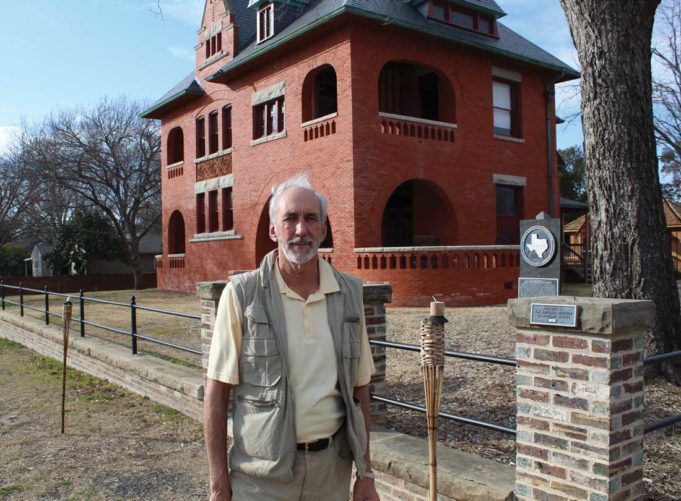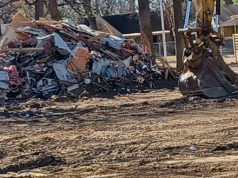The built environment of Arlington Heights has long melded into the surrounding urban landscape, but not everyone has forgotten its rich 127-year-old history. Brent Hyder, a developer who grew up in the historic neighborhood, has recently become an advocate for protecting it from what he said is increasingly harmful development. Dozens of large homes and upscale townhomes have recently taken root alongside more modest native homes that date back a century or more.
The area is “getting outside developers who see opportunities to buy properties at a very reasonable price,” Hyder said. “Knowledge of history and a passion for this area are our only defense against inappropriate development.”
Hyder and dozens of like-minded locals were handed a victory last month when Fort Worth City Council voted eight to one to deny a zoning change request from area business owner Walter Matyastik. Councilmember Cary Moon cast the lone vote in favor of the request. Matyastik, who had recently purchased a large lot near Camp Bowie Boulevard, requested that his property be rezoned to allow for a residential suite on the third floor where he planned to live. Matyastik made his case before city council that his 14,000-square-foot building, with its proposed mixed-use retail, would add “quality and value to the city.”
Councilmember Dennis Shingleton echoed the thoughts of several speakers, who represented four nearby homeowners associations, when he described the architectural plans as not befitting the historic nature of the area. Whereas retail and commercial stores are largely recessed from Camp Bowie where the boulevard crosses Arlington Heights, Matyastik’s proposal would have stuck out.
Area residents were previously voicing concern last summer when Rob Sell, owner of V Fine Homes, was looking to build on his property near Boulevard Heights Elementary School (formerly Arlington Heights Elementary). To allow for the two-story, 6,500-square-foot flatiron building that would have housed retail and office space, Sell was requesting a zoning change from F (general commercial) to MU-1 (low-intensity mixed-use). The biggest source of friction for many area residents was the incorporation of street parking along the boulevard. City Council voted five to four against the zoning request. I reached out to Councilmember Shingleton, whose district encompasses Arlington Heights, but he declined to comment on this story.
Sell told me in a phone interview that his plan had overwhelming support from the Arlington Heights residents he spoke with. His development would have made use of street parking, he said, but the impact would have been minimal because of the light foot traffic his business would have generated and plans he had to create additional parking.
“When the notifications went out to the neighborhood, they thought we were providing zero parking spaces for my property,” he said. “We tried to communicate that there were parking spaces that could be restriped along with new spaces.”
Jerre Tracey, executive director of the historic preservation nonprofit Historic Fort Worth Inc., said Arlington Heights faces uniform development challenges because it lacks a historic district designation. Without that historic overlay, which must be approved by the city’s Historic & Cultural Landmarks Commission, the neighborhood’s only protection is city zoning.
“Without a historic district [designation], there is no continuity of view, scale, and size,” she said. “When these neighborhoods were built, they were [laid out] in a logical way. Now, unbridled development [is working outside of] these guidelines.”
When a neighborhood loses its historic identity, she added, property owners risk losing money on their investments.
Tracey points to Fairmount as a neighborhood that have successfully implemented a historic overlay. Once the new guidelines are set, residents must stay active to ensure they are followed closely.
“Continuity matters,” she said. “It’s almost a basic food group in development, the key principle that helps the neighbors.”
Many developers, she added, are beginning to build in a way that respects tradition while looking toward the future.
City planning manager Jocelyn Murphy said in an email that the Arlington Heights neighborhood “has been very active for the last decade and continues to be so,” with regard to new development.
Requests for zoning changes and variances (minor zoning changes) haven’t risen sharply in recent years, but she expects commercial interests to increase along Montgomery Street (a few blocks east of Arlington Heights) as the nearby 14,000-seat Dickies Arena nears completion next year.
Sell said he plans to build on his property once he works out a parking solution, which may include a first-floor parking garage. Anything he builds will be designed with the historic nature of Arlington Heights in mind, he added.
“I do admire the passion with which the neighbors in Arlington Heights defend their territory,” he said. “I think they tend to carry it a little too far. I think there is a group of people who would just as soon see Fort Worth be a sleepy little town rather than an urban city, which it is.”
The neighborhood, he said, has become a “well-oiled machine of opposition” to new development. He worries that many within that opposition lack an “objective perspective” to differentiate between good and bad development.
Hyder recently purchased one of four remaining homes that were built in 1893 as part of the original Arlington Heights development. The three-story building had electricity and hot water when it was first built — a novelty at that time. The neighborhood’s founders had grand ambitions for Arlington Heights, which included Arlington Heights Boulevard, itself later renamed after slave trader and gambler James Bowie in 1921. Much of the neighborhood’s history has been forgotten by Fort Worthians, he added. He hopes that renewed interest in the neighborhood may one day spur interest in preserving what remains.
“An historic overlay seems unlikely,” Hyder conceded. “There are many stakeholders in Arlington Heights who’d have to agree. For now, we’re having to respond to everything as it comes up.”













“Arlington Heights Boulevard, itself later renamed after slave trader and gambler James Bowie in 1921”
Really? A little red meat for your article? So was Bowie’s middle name Camp or did it actually have something to do with the WWI military base that was bisected by the road?
This is super interesting. Good story, Edward. I moved here from the East Coast, and love living in Fort Worth. Arlington Heights is not where I personally live, though I work on Camp Bowie, and it’s such a serene neighborhood, it would truly be a shame to have anything rezoned for commercial enterprise in the established residential area.